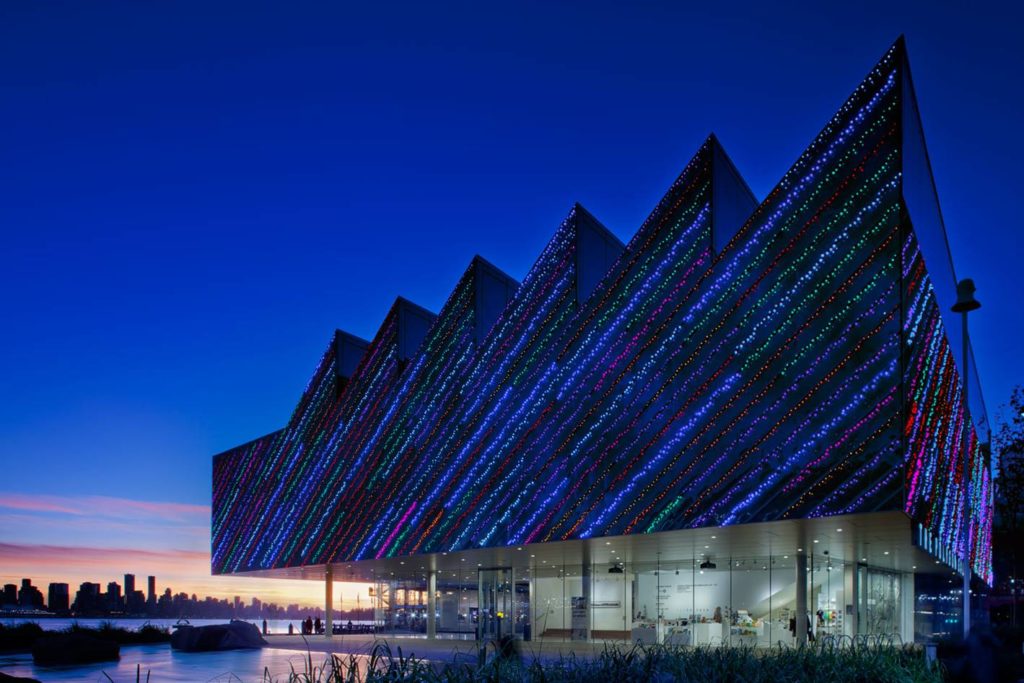“Run to You.” “Summer of ’69.” “One Night Love Affair.”
With songs like these, blaring out of car speakers and AM radios from Victoria to St. John’s in the mid-1980s, Bryan Adams’s Reckless became the first Canadian album to sell more than a million copies in Canada.
But has this classic-rock album ever gotten a tribute in contemporary public art? Perhaps not—until now.
Currently, at the Polygon Gallery in North Vancouver—the city where Adams spent much of his youth—one can find another take on Reckless.
There, on the facade of the Polygon Gallery, award-winning BC artist Kevin Schmidt has installed coloured lights and sounds that riff, in ways both sincere and ironic, on an album that is still a presence today. (As of this month, Bryan Adams has nearly 10 million monthly listeners on Spotify, with three singles from Reckless in his top five tracks there.)
This is not the first time Kevin Schmidt has addressed pop music through his art. His film Long Beach Led Zep, created in 2002 and in the collection of the National Gallery of Canada, juxtaposes a west-coast beach with “Stairway to Heaven.” His installation and film EDM House, created in 2014, pairs a lit-up rural cabin with dance music.
Now, Schmidt’s artwork at the Polygon, called Reckless after its namesake, is up until May 21. Here, Schmidt talks about why he made this public piece, what Bryan Adams has to teach us about contemporary aesthetic taste, and more.
Leah Sandals: You’ve done several artworks kind of inspired by or paired with specific musical tracks. How do you know or sense when a piece of music is something you want to address in an artwork?
Kevin Schmidt: Often the way it works for me is it’s not usually music first—it’s context first, and then the music comes to mind. And often it’s not a particular music composition that I start think about, but more of a genre.
For example, for Long Beach Led Zep I was living in Tofino. I was surfing, so I was out on the beaches a lot, and I was working in Vancouver a few days a week, so I was driving a lot past Long Beach.
While living there, I knew I wanted to bring a generator and Marshall stacks out onto a wilderness beach—but it took me a while to hit on the right piece of music for that. And then, in the end, I just decided to go with the most cliché guitar-rock song that I could think of, I guess as a touchstone or lowest common denominator.
LS: For me, as someone who grew up listening to pop radio in Winnipeg in the 1980s, Reckless was a major soundtrack of my youth. How did you experience this album when it first came out? What song most struck you then?
KS: I was around 13, I think, when it came out. I didn’t buy the album, but I remember hearing the songs on the radio a lot—and then, of course, as I got older, that’s what I would hear as a Canadian content played on the radio all the time.
I like the album quite a bit. I like the kind of sound on the album, I like the kind of production—it’s rock, but it’s kind of new wave in its production, with the synthesizer. I think that kind of sound is very melodic and catchy with a slight kind of production edge. That’s what I heard, at least, and that’s always kind of stayed with me.
LS: What’s your own personal experience playing music or recording music?
KS: Starting as a teenager, I was playing guitar and writing my own songs. And then, as a young adult, I was playing in bands garage bands and that kind of thing. We were recording music—like four-track on cassette—and playing gigs around Vancouver, and that was continued all through my art-school experience.
After art school, I had to make a decision: Am I going to be a musician, or am I going to be an artist?
I ended up being an artist because I had always dealt with an anxiety about performing onstage—which is ironic because I’ve started using performance in my own practice, and as a visual artist you are always performing anyway.
LS: What do you mean by “as a visual artist you are always performing anyway”?
KS: Well, I’m doing this interview, for example. Or on social media. Or if someone is interested in an exhibition they send a photographer who inevitably wants to take a photo of you in front of an artwork. And then, if you have a successful exhibition, people want you to do an artist talk.
I wanted to be a visual artist because I wanted to make things that would stand in the world [on their own]. But what you realize very quickly is that people want to see a person performing.
LS: So how did this public art piece about Bryan Adams’s Reckless come about?
KS: It started with the opening of the Polygon Gallery in 2017. I was a part of a group exhibition for the opening that was all about the context of North Vancouver. I proposed this work for that show—Bryan Adams is from North Vancouver and parts of the songs on Reckless were recorded or written there.
So that was the initial impulse. Unfortunately because of construction going on on outside of the gallery, we weren’t able to install it during that show. So the piece had to be delayed to this past fall, when we were finally able to install it.
LS: What are some other important aspects of this public art piece, in your view?
KS: Have you been to the Polygon Gallery? It’s a quite a calculated bit of architecture, if you know what I mean: it’s quoting a kind of Modernism, I think, as a symbol that it’s a showpiece kind of building.
I said before that I like the Reckless album. I think that they’re good pop songs. But at this point in time, it’s kind of a guilty pleasure, because it’s kind of cliché or a bit cheesy now.
So what I wanted to do was talk about this building—the art gallery—as a kind of [cultural] tourist generator, because the building looks a certain way. And then I wanted to equate that with most low-common-denominator pop songs, like Bryan Adams—to make fun of that pretension, in a way, but also think about it fondly.
So there’s a bit of ambivalence in there. Basically the architects were trying to make a serious Minimalist-Modernist kind of building, and I’m kind of trashing it up by putting sentimental Christmas lights on it that are also playing “unserious,” “lowbrow,” “commercial pop music” on it.
LS: And how do the lights interact with or dovetail with the songs?
KS: The actual mechanics are that there are Christmas lights draped along all outside the building. There is an angled dimension to the architecture, and I’m replicating that with the way I put the Christmas lights on the architecture.
These lights are all hooked up to computer controllers. I’m making cover versions of all of the singles from the Reckless album and then composing lighting animations that sync with them. The controllers also play these songs back, which you can hear from the speakers underneath the gallery, and also hear on FM.
LS: What has reaction been like so far?
KS: It’s hard for me to say, because I’m not living in Vancouver right now. What I do know that is over Christmas I was in Vancouver and I got to go see it in person, rather than a simulator on my computer. I’m pleased. I think it works really well. I think it’s really fun.
Another way I’ve thought about this piece is that this gallery—the old Presentation House Gallery, now the Polygon Gallery—had this big move to try and make it an international destination. And that’s essentially what Reckless did for Bryan Adams: it’s what put him on the international map.
So I see it as a kind of analogue. That’s why I think that this album in particular works: it’s funny to drape that kind of sentimentality, but also this ambition, onto this building, this institutional endeavour.
Also, it’s important that the music is playing out of the soffit speakers of the building, which is kind of this degraded way to listen to music—it’s small speakers, not high fidelity. So the way I’m covering the songs is by slowing them down and washing them out and thinking of them as hipster elevator music.
I’m draping the building with this display, and I’m also draping the Bryan Adams production with these different kinds of markers of taste, which complicate each other.
LS: Now I have to what some might deem a distasteful question: Does Bryan Adams know about this artwork?
KS: I don’t know if he knows. I haven’t contacted him directly. I hope he gets to see it, and I hope he likes it.
I am talking about this album as “lowest common denominator”—I’m being disparaging. But I’m actually doing this piece because I think these songs are good. There is something really good about them that merits my continued investment in them.
“Kevin Schmidt: Reckless” will on view daily from 5:30 to 11 p.m. at the Polygon Gallery in North Vancouver until May 21. The soundtrack can be heard on site during activation hours, or by tuning in to 87.8 on FM radio.
This interview has been edited and condensed.

 A view of the light-and-sound work Reckless by Kevin Schmidt, installed on the Polygon Gallery building in North Vancouver. Photo: Robert Stefanowicz.
A view of the light-and-sound work Reckless by Kevin Schmidt, installed on the Polygon Gallery building in North Vancouver. Photo: Robert Stefanowicz.






